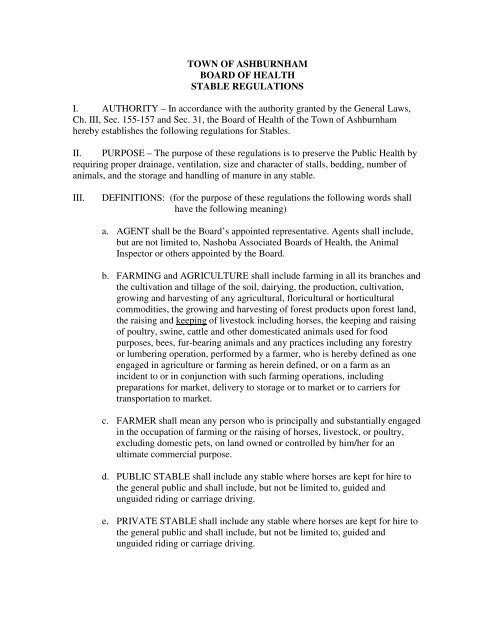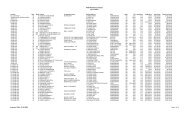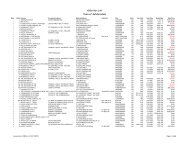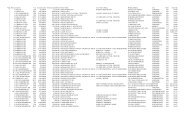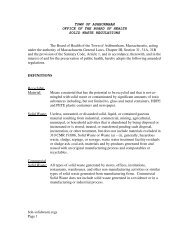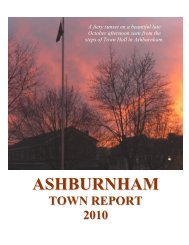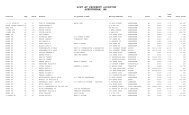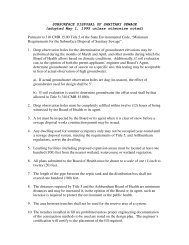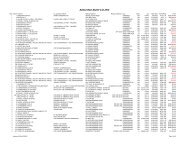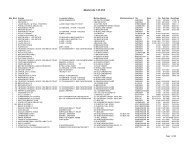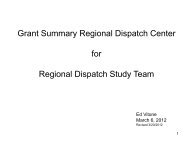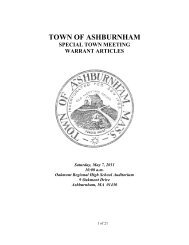Stable Regulations - Town of Ashburnham, Massachusetts
Stable Regulations - Town of Ashburnham, Massachusetts
Stable Regulations - Town of Ashburnham, Massachusetts
Create successful ePaper yourself
Turn your PDF publications into a flip-book with our unique Google optimized e-Paper software.
TOWN OF ASHBURNHAMBOARD OF HEALTHSTABLE REGULATIONSI. AUTHORITY – In accordance with the authority granted by the General Laws,Ch. III, Sec. 155-157 and Sec. 31, the Board <strong>of</strong> Health <strong>of</strong> the <strong>Town</strong> <strong>of</strong> <strong>Ashburnham</strong>hereby establishes the following regulations for <strong>Stable</strong>s.II. PURPOSE – The purpose <strong>of</strong> these regulations is to preserve the Public Health byrequiring proper drainage, ventilation, size and character <strong>of</strong> stalls, bedding, number <strong>of</strong>animals, and the storage and handling <strong>of</strong> manure in any stable.III.DEFINITIONS: (for the purpose <strong>of</strong> these regulations the following words shallhave the following meaning)a. AGENT shall be the Board’s appointed representative. Agents shall include,but are not limited to, Nashoba Associated Boards <strong>of</strong> Health, the AnimalInspector or others appointed by the Board.b. FARMING and AGRICULTURE shall include farming in all its branches andthe cultivation and tillage <strong>of</strong> the soil, dairying, the production, cultivation,growing and harvesting <strong>of</strong> any agricultural, floricultural or horticulturalcommodities, the growing and harvesting <strong>of</strong> forest products upon forest land,the raising and keeping <strong>of</strong> livestock including horses, the keeping and raising<strong>of</strong> poultry, swine, cattle and other domesticated animals used for foodpurposes, bees, fur-bearing animals and any practices including any forestryor lumbering operation, performed by a farmer, who is hereby defined as oneengaged in agriculture or farming as herein defined, or on a farm as anincident to or in conjunction with such farming operations, includingpreparations for market, delivery to storage or to market or to carriers fortransportation to market.c. FARMER shall mean any person who is principally and substantially engagedin the occupation <strong>of</strong> farming or the raising <strong>of</strong> horses, livestock, or poultry,excluding domestic pets, on land owned or controlled by him/her for anultimate commercial purpose.d. PUBLIC STABLE shall include any stable where horses are kept for hire tothe general public and shall include, but not be limited to, guided andunguided riding or carriage driving.e. PRIVATE STABLE shall include any stable where horses are kept for hire tothe general public and shall include, but not be limited to, guided andunguided riding or carriage driving.
f. TURNOUT shall mean a fenced-in area in which a horse is let free for thepurpose <strong>of</strong> self exercise.g. Lot shall mean a parcel <strong>of</strong> land owned by a person that is deeded and recordedto show ownership, dimension, lot lines and may include existing buildings.h. VECTOR CONTROL shall mean the effective control <strong>of</strong> insects and rodentsso that they do not cause a Public Health nuisance.i. STABLE shall mean a structure used to provide shelter for a horse.IV.EXISTING STABLES:All existing horse owners must apply for a <strong>Town</strong> <strong>of</strong> <strong>Ashburnham</strong> <strong>Stable</strong> Permit.The owners <strong>of</strong> horses must apply for the permit within ninety (90) days from thedate these regulations are published. The only sections <strong>of</strong> these regulations toapply to existing stables are, VII. Sanitary Controls and X. Locations (exceptsubsection d). Those owners <strong>of</strong> existing stables, who can not meet these specificsections, may apply for the needed variances.V. APPLICABILITY OF PERMIT:a. Owners <strong>of</strong> land who qualify as “Agriculture or Farming” under M.G.L. Ch.128, Sec. 1A and whose owner/operator is a Farmer are exempt from theseregulations.b. All other landowners and owner/operators must apply for a Public or Private<strong>Stable</strong> Permit as applicable by definition and meet the <strong>Stable</strong> <strong>Regulations</strong> inorder to be issued a <strong>Town</strong> <strong>of</strong> <strong>Ashburnham</strong> <strong>Stable</strong> Permit.c. Once issued the stable license will remain in effect until the property ownersells the property for which the license has been issued. Licenses are nottransferable without the prior approval <strong>of</strong> the Board <strong>of</strong> Health.VI.APPLICATION FOR A PRIVATE OR PUBLIC STABLE PERMITApplicants for a stable permit shall do the following:a. read the <strong>Ashburnham</strong> <strong>Stable</strong> <strong>Regulations</strong>,b. submit the completed applications and fee to the Board <strong>of</strong> Health, or its Agent(fee to be set in the spring <strong>of</strong> 1998 by a <strong>Town</strong> Meeting vote)c. comply with the regulations as written.
VII.SANITARY CONTROLSa. In general, the following minimum sanitary requirements are to be met.1. All horses are to be maintained in a clean and healthy manner.2. Insects (flies) shall be controlled through the use <strong>of</strong> fly tapes, sprays, fogsand/or other means demonstrated effective in the stable(s) and around themanure storage area.3. Vermin (mice, rats and other rodents) shall be controlled through the use<strong>of</strong> bait boxes, traps and/or other means demonstrated effective.4. The sanitary maintenance <strong>of</strong> the stable and manure storage area andproperty storage <strong>of</strong> feed shall reduce the incidences <strong>of</strong> vectors.5. Grain must be kept in a rodent-pro<strong>of</strong> container.6. ManureVIII. HOUSINGa. Stalls must be cleaned daily.b. Manure will not be allowed to drain or run-<strong>of</strong>f into any wetlands orwater resource area.c. Manure shall be stored to prevent vector problems.d. No more than one (1) cord (128 cu. ft.) <strong>of</strong> manure and bedding shall beallowed to accumulate on the property, nor shall the storage there<strong>of</strong>cause nuisance to abutters or the public. Exceptions to this may begranted by the Board if the applicant demonstrates that the manure canbe stored without causing a nuisance.All horses must have access to shelter. The minimum requirements for theprovided shelters are found in the guidelines by the <strong>Massachusetts</strong>Department <strong>of</strong> Agriculture, Division <strong>of</strong> Animal Health.
IX.LOT REQUIREMENTSa. All persons requesting a private stable permit shall have enough land tomaintain their animals in a sanitary manner and one which does not create anuisance to their abutters.b. All persons requesting a public stable permit shall have at least five (5) acres<strong>of</strong> land.c. All fencing shall be a minimum <strong>of</strong> four (4) feet in height and may consist <strong>of</strong>wood, woven wire, electric-charged fencing with signs every 50 feet, stonewalls or other materials that will effectively contain but not be harmful to theanimals. Barbed-wire fencing WILL NOT be permitted.X. LOCATIONSa. All turnout areas and stables must be 50 feet from vegetated wetlands and 100feet from the actual water’s edge.b. All manure must be stored at least 100 feet from all wetlands.c. All turnout areas, manure storage and stables must be 100 feet from privatewells.d. All turnout areas, manure storage and stables shall be at least 100’ from theabutter’s residences. The Board may increase this distance to protect thepublic health. Upon submission <strong>of</strong> an application for a stable permit, theBoard, or its Agent, reserves the right to inspect the location <strong>of</strong> the proposedstable to determine compliance with this section is met.XI.DEAD ANIMALSDead animals shall be buried, incinerated, or disposed <strong>of</strong> promptly in such a wayas to prevent the attraction <strong>of</strong> files and the generation <strong>of</strong> odors. If an animal mustbe destroyed, it shall be done in a humane matter. If buried, the animal shall beput in a hole, the bottom <strong>of</strong> which shall be a minimum <strong>of</strong> four (4’) feet above highgroundwater and covered with at least six (6) feet <strong>of</strong> compacted dirt. The burialsite shall be at least fifteen (15) feet from property lines and one hundred (100)feet from any well or wetlands. The Board <strong>of</strong> Health, or its Agent, must benotified <strong>of</strong> the proposed burial site in advance. If unable to contact the Board <strong>of</strong>Health in a timely manner on weekends or holidays, then the animal may beburied in accordance with the restrictions outlined above and the Board <strong>of</strong> Healthnotified on the first working day following the burial.
XII.VARIANCE CLAUSEVariances may be granted by the <strong>Ashburnham</strong> Board <strong>of</strong> Health with respect toany particular case when, in its opinion, the applicant has provided that the samedegree <strong>of</strong> compliance can be achieved without strict application <strong>of</strong> the particularprovision.The process for obtaining a variance is listed below.a. Submit a written request, which shall include the following information;specific section(s) <strong>of</strong> the regulations which relief is sought, the reasons for therequest and may include any sketches or additional information that would beuseful to the Board in making its decision. The Board will schedule therequested hearing within sixty (60) days <strong>of</strong> the request.b. All abutters shall be notified <strong>of</strong> the variance hearing at least ten (10) daysprior to the hearing by certified mail. The return receipts shall be presented tothe Board <strong>of</strong> Health at the hearing.c. At the hearing the applicant may present their request(s) and any relatedmaterials. If the Board feels that a site visit is warranted, it will continue thehearing until the visit can be arranged.d. Once the hearing is closed, the Board will vote on the requested variance(s).XIII. ENFORCEMENTThese regulations can be enforced by the Board <strong>of</strong> Health, the Animal Inspector,the Nashoba Associated Board <strong>of</strong> Health, or by any other appointed Agent <strong>of</strong> theBoard.XIV. SEVERABILITY CLAUSEIf any section, paragraph, sentence, clause or phrase <strong>of</strong> these rules and regulationsis held invalid or unconstitutional by a court <strong>of</strong> competent jurisdiction, suchportion shall be deemed a separate and distinct provision and such decision shallnot affect the validity <strong>of</strong> the remaining portion <strong>of</strong> the regulations which shallremain in full force and effect, and to this end, the provisions <strong>of</strong> the rules andregulations are hereby declared severable.XV.PENALTIESFollowing notice <strong>of</strong> violation <strong>of</strong> any section <strong>of</strong> the preceding regulations, and areasonable time for the correction, the owner or agent responsible for suchviolation may be subject to a fine <strong>of</strong> five (5) dollars per day that said violationsexist and to the revocation <strong>of</strong> his/her permit (M.G.L. Ch. 111, Sec. 157).


